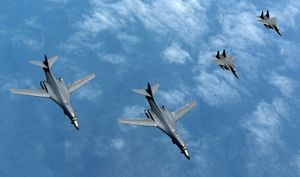The U.S. Air Force (USAF) dispatched two B-1B Lancer heavy strategic bombers from Andersen Air Force Base on Guam in the Western Pacific to conduct drills with Japan Air Self-Defense Force (JASDF) F-15J Eagles fighter jets and Republic of Korea Air Force (ROKAF) F-15K Slam Eagles in the vicinity of Kyushu, Japan, the East China Sea, and the Korean Peninsula on June 20, according to a Pacific Air Forces statement.
The ten-hour mission involving two separate bilateral military drills with the JASDF and ROKAF took place hours after the death of Otto F. Warmbier, a U.S. citizen who was recently evacuated from North Korea, was announced. The 22-year old was undergoing treatment at a hospital in Cincinnati, Ohio, since his release from North Korean captivity last week for “humanitarian” reasons. It was there that he passed away yesterday afternoon.
According to the U.S. military, the joint exercises with JASDF and ROKAF ”demonstrate solidarity between Japan, ROK and the U.S. to defend against provocative and destabilizing actions in the Pacific theater.” The two bombers, part of the 9th Expeditionary Bomb Squadron, can each carry up to 75,000 pounds (34,000 kilograms) of weapons—the largest payload of both guided and unguided weapons in the U.S. Air Force’s inventory. As I explained before:
B-1Bs of the 9th Expeditionary Bomb Squadron deployed to the Asia-Pacific in support of United States Pacific Command’s continuous bomber presence mission in the region this February. The unit replaced B-1B bombers and over 300 airmen from the 34th Expeditionary Bomb Squadron (28th Bomb Wing), which deployed to Guam from Ellsworth Air Force Base, South Dakota in August last year–the first deployment of B-1B bombers to Guam in over a decade.
The U.S. military has been stepping up its activities in East Asia in the face of North Korea’s growing ballistic missile threat over the last months, which included an increase in the number of B-1B training exercises and patrols with allies.
For example, a B-1B bomber conducted training missions with JASDF and ROKAF aircraft in March. In September 2016, a B-1B, escorted by U.S. Air Force F-16 fighter jets and ROKAG F-15K aircraft, performed a low-level flight near the Demilitarized Zone (DMZ) on the Korean Peninsula–the closest a B-1B bomber had ever flown to the border separating North and South Korea.
However, B-1B training flights have not just been confined to the Korean Peninsula. Earlier this month, two B-1B bombers from Andersen Air Force Base also conducted a training exercise in the South China Sea in conjunction with the U.S. Navy’s Arleigh Burke-class guided missile destroyer USS Sterett. In response, China announced that it remains vigilant as the United States is stepping up its military presence in the disputed waters.

































